



Overview of SERDP & ESTCP Investments in Improving our Understanding of Vapor Intrusion Andrea Leeson, Ph.D. SERDP/ESTCP ER Program Manager
2001 2006 Chlorinated Solvents Workshop DNAPL Workshop Research Need Research Need Improved Prediction of the Risks to Indoor Air Better Understanding & Monitoring of Vapor from Soil Vapors Transfer from Sources Additional field studies at a variety of sites to Develop a better understanding of processes understand conditions at which vapor to controlling vapor attenuation indoor air may be a significant risk pathway; Develop improved monitoring techniques and Upgrading of currently-used models to make methods to discern between subsurface and them more realistic, using data from real- surface sources of chlorinated solvents in world DoD sites for calibration; indoor air Technical transfer of information that is available to RPMs & their consultants. Development of Screening & Exit Criteria for VI Assessments (ER-0423 & ER-0707) Dem/Val Application of Advanced Sensor Technology (ER-0702) Low-Cost Alternatives for Sampling & Analysis of VOCs (ER-0830) FY02 FY03 FY04 FY05 FY06 FY07 FY08 FY09 FY10 FY11 2
Improved Understanding of the Vapor Intrusion Pathway from Chlorinated Solvent-Contaminated Groundwater Plumes Objective: Produce fundamental and applied research ● that leads to better pathway assessment for vapor intrusion from chlorinated solvent-contaminated groundwater. Specific objectives include: - Gain a better understanding of natural spatial and temporal variations in vapor intrusion measurements and how to account for such variability in pathway assessment. - Improve our ability to obtain accurate and cost-effective characterization of key site parameters that impact the vapor intrusion pathway. - Improve our ability to predict vapor behavior under various physical, climatic, and/or geochemical conditions. - Improve our understanding of vapor attenuation mechanisms. 3
Integrated Field-Scale, Lab-Scale, & Modeling Studies for Improving Ability to Assess Groundwater to Indoor Air Pathway at Chlorinated Solvent-Impacted Groundwater Sites (ER-1686) Principal Investigator: Dr. Paul ● Johnson (Arizona State University) Key research topics ● Temporal variability of indoor air concentrations Relationship between groundwater concentrations and indoor air impacts ? Spatial & temporal variability in sub-slab and near-foundation soil gas Changes with time in vapor emissions from chlorinated solvent groundwater plumes Investigation of alternate Capillary fringe assessment monitoring approaches Dissolved chlorinated solvent Indoor chemical sources groundwater plume 4
Vapor Intrusion From Entrapped NAPL Sources and Groundwater Plumes: Process Understanding and Improved Modeling Tools for Pathway Assessment (ER-1687) Principal Investigator: Dr. Tissa Illangasekare (Colorado School of Mines) ● Overall objective: To improve understanding of processes & mechanisms of vapor ● generation, migration, & attenuation in a naturally heterogeneous vadose zone under various natural physical, climatic, & geochemical conditions Understand the mechanisms of vapor generation from contaminant source zones under varying hydrogeologic and climatic conditions. Understand processes & mechanisms that contribute to spatially & temporally varying measurements of soil moisture & vapor concentrations in vadose zone & how to account for such variability in VI & pathway assessment. Evaluate the ability of existing modeling tools to capture the fundamental processes of vapor generation, migration and attenuation and up-scale them for field sites with varying hydrogeologic and climatic conditions. Influence zone of building Fluctuating river Infiltration Source Zone Building stage Vapor ET plume Pumping well Fluctuating water Vapor table flux Subsurface migration pathway Dissolved plume 5
ER-0423: Detailed Field Investigation of Vapor Intrusion Processes Principal Investigator: Tom McHugh (GSI Environmental) ● Objective: To identify a cost-effective and accurate ● protocol for investigating vapor intrusion into buildings overlying contaminated groundwater. Three performance goals were established, and all ● objectives were met: Collection of data representative of site conditions Determination of vapor intrusion impacts at demonstration sites (i.e., indoor air concentration of chemical above risk-based screening limit, not attributable to background indoor air sources) Development of a reliable vapor intrusion investigation approach (i.e., identify a limited scope investigation approach with higher accuracy than current approaches). 6
ER-0707: Protocol for Tier 2 Evaluation of Vapor Intrusion at Corrective Action Sites Principal Investigator: Tom McHugh (GSI Environmental) ● Objective: Develop and validate Tier 2 procedures for screening ● vapor intrusion at corrective action sites along with exit criteria indicating no further need for site evaluation. Builds on data from ER-0423 ● Procedures will use easily obtainable site-specific information to ● support the application of screening concentrations that are less conservative than the Tier 1 screening concentrations provided in U.S. EPA and many state vapor intrusion guidance documents. The Tier 2 procedures will fill the current gap in available guidance ● documents between generic (Tier 1) screening concentrations and detailed site investigations of vapor intrusion. 7
ER-0702: Application of Advanced Sensor Technology to Soil Vapor Intrusion Problems Principal Investigator: Jim Reisinger (IST) ● Objective: To take existing and emerging technology and build and ● demonstrate sensor packages for VI applications. Specific project objectives include: Screening available advanced sensor technologies Selecting the most promising technology for VI - The SPIRON micro-gas chromatograph (micro-GC; Dr. Ted Zellers, University of Michigan) sensor technology was selected in Phase I Building and demonstrating sensor packages for the following VI applications: - Portable “sniffer” unit for near real-time compound-specific determination for contaminant source assessment - Fixed “smoke detector” unit for compound-specific exposure concentrations interfaced with remote communications. 8
ER-0830: Development of More Cost-Effective Methods for Long-Term Monitoring of Soil Vapor Intrusion to Indoor Air Using Quantitative Passive Diffusive-Adsorptive Sampling Techniques Principal Investigator: Todd McAlary (Geosyntec) ● Objective: To demonstrate the applicability of lower-cost ● alternatives for sampling and analysis of VOCs in indoor air and soil gas during investigation of subsurface vapor intrusion to indoor air. Four distinct types of passive diffusive samplers will be tested against two active gas sampling methods under controlled laboratory conditions and under field conditions - SKC Ultra II Passive Sampler - Crump - PDMS Sampler - Radiello Sampler 9
Additional Information www.serdp.org ● www.estcp.org ● Andrea.Leeson@osd.mil ● 10
Recommend
More recommend